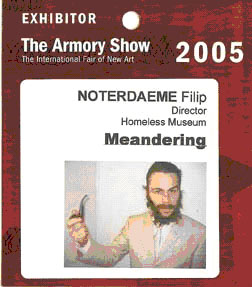|
Art Fairs
International, Summer 2005
ARMORY
SHOW
HoMu Unplugged: The Homeless Museum at the Armory Show 2005
By Filip Noterdaeme

When Gabrielle Giattino from the Swiss Institute invited me
to create a performance for this year’s Armory Show,
we launched an interactive installation that would bring my
brainchild, the Homeless Museum (HoMu) into contact with the
international art world. The barebones HoMu “unplugged”
performance would run for the duration of the five-day fair.
The set-up was simple: I built a small wooden stand, fashioned
after Lucy’s Psychological Advice booth from Charles
Schultz’ Peanuts. Two kindergarten chairs completed
this “Homeless Museum.” Plastic letters glued
on my rough wooden stand spelled the catchphrase “The
Director is IN.”
Most visitors responded with great enthusiasm to this manifestation
of Lucy’s booth. Long, engrossing confessional sessions
with complete strangers followed. We talked about the fair
(I praised the design of the exhibitors’ booths and
the gray carpeting that covered the entire floor of the premises),
about the status of the contemporary artist (I suggested artists
reclaim a culturally significant role by all becoming museum
directors) and about cultural institutions (I admonished that
to prevent corruption they give up their “missions”).
Sometimes, statements freely borrowed from the MTA (“If
you see something, say something”) succeeded at spicing
up the conversation. This enabled me to send people out on
safety watches (“Go discover a suspicious work of art”)
or to advise them (“Give to charity, just not here”).
Photographers flocked to my booth; handymen got a kick out
of the fact that unlike Lucy I didn’t actually charge
for services; and artists and gallery owners stopped by, warming
up to my buffoonery. In the end, my act revealed a human (and
humorous) element so sadly missing in the rest of the art
fair, where territorial exhibitors cordoned their booths off
at closing time with yellow traffic tape, apparently without
any sense of irony.
My appearance—complete with fake fuzzy beard, equally
fake crocodile shoes, unlit pipe, pink Paul Smith suit, and
orange and baby-blue Burlington Socks—did trigger curiosity.
But ultimately, it was the eccentric persona that drew people
to my booth. Oh, some were rude, disrespectful, and self-righteous,
completely ignorant or unwilling to explore what I was driving
at. The fact that my stand offered none of the comfort of
the seller-and-buyer-model, nor that model’s clear behavioral
guidelines made them nervous. I quickly dismissed those who
wished to give me a hard time in favor of those who were game
and could see beyond the masquerade.
If I grew more and more comfortable with the role I had taken
on as the days went by, the exhibitors slowly crumbled under
the pressure of their efficient salespeople facades. Facial
hair sprouted, other hair became unkempt, clothes rumpled,
and a growing fatigue began to manifest in their reddening
eyes. Frequent trips to the miserable concession stand—$4
for a small bottle of water and a candy bar—aided in
accelerating such disintegration. To me, like the art they
were showcasing, these brokers were all homeless, adrift in
the art world’s maelstrom. When the time came to dismantle,
the event’s ravaged once-glamorous facade vanished within
minutes. Makeshift walls disappeared, and the space was rendered
inhabitable once again. Like hobos on the run, we packed art
pieces into crates, heaved them onto dollies and rushed to
the exit.
This was my first real outing as an artist, besides a small
presentation of my work in an artist’s studio in 2003,
a gallery installation and some well-publicized activism surrounding
MoMA’s controversial re-opening. My agenda this time
was different altogether: Nothing to sell, everything to give.
To me, the whole Armory Show had become a homeless museum,
one that I appropriated through my presence and my generous
project. I even created a limited-edition sleeve for the show’s
catalogue, effectively pocketing the entire event.
In conjunction with my performance at the fair, the organizers
of the Armory Show announced a VIP brunch and private tour
of the newly established headquarters of the Homeless Museum,
which is located in my own home in keeping with my only credo,
“homelessness begins at home.” The strictly limited
RSVP list filled within only two days of the announcement,
but on Sunday, March 13, all 28 listed VIPs failed to show.
In their place came a haphazard group of supporters and friends
as well as the curious and the ambivalent. The Homeless Museum
continues to be open to the public by appointment, free of
charge.
If art is increasingly considered as a commodity, one purchased
with a calculative, rather than an open mind, the Homeless
Museum acts as a barometer of the value of art in the 21st
century. Since the greats from Beuys to Warhol have told us
that everyone can be an artist, and make art a successful
business, a strange misunderstanding seems to have crept in:
artistic identity is taken for granted, and the main focus
has turned on generating funds. Once part of the anti-establishment,
artists have jumped into the maw of the corporate world, oblivious
to the fact that the corporate world routinely spits out what
it chews.
|
